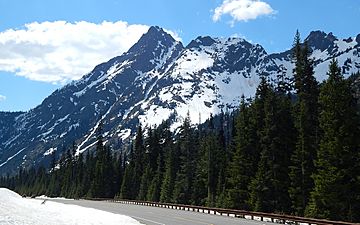Whistler Mountain (Washington) facts for kids
Quick facts for kids Whistler Mountain |
|
|---|---|

Whistler Mountain seen from North Cascades Highway
|
|
| Highest point | |
| Elevation | 7,790 ft (2,370 m) |
| Prominence | 590 ft (180 m) |
| Geography | |
| Location | Chelan County, Washington |
| Parent range | North Cascades |
| Topo map | USGS Washington Pass |
| Climbing | |
| Easiest route | Climb, class 3 |
Whistler Mountain is a mountain summit that stands 7,790 feet (2,374 meters) tall. It is located in Chelan County, Washington state. This impressive peak is part of the Okanagan Range. The Okanagan Range is a smaller part of the larger North Cascades mountain system.
Whistler Mountain is found about two miles west of Washington Pass. It is also one mile east of Rainy Pass. The North Cascades Highway curves around the southern base of the mountain. This highway connects these two important mountain passes. A high ridge connects Whistler Mountain to its closest taller neighbor, Cutthroat Peak. Cutthroat Peak is about 0.78 miles (1.26 km) to the north-northeast. Water from the mountain, like rain and melting snow, flows into Bridge Creek.
Mountain Climate
Whistler Mountain is located in a marine west coast climate zone. This type of climate is common in western North America. Most weather fronts, which are boundaries between different air masses, start in the Pacific Ocean. They then travel northeast towards the Cascade Mountains.
As these weather fronts get closer to the North Cascades, the tall peaks of the Cascade Range force the air upward. This process is called Orographic lift. When the air rises, it cools down and drops its moisture. This moisture falls as rain or snowfall onto the Cascades. Because of this, the western side of the North Cascades gets a lot of rain and snow. This is especially true during the winter months.
In winter, the weather is often cloudy. However, during the summer, high-pressure systems over the Pacific Ocean become stronger. This often leads to clear skies with little or no clouds. Because of the ocean's influence, the snow in this area tends to be wet and heavy. This can create a high risk of avalanches, which are dangerous slides of snow down a mountain.
How the Mountain Formed
The North Cascades area has some of the most rugged land in the Cascade Range. You can see jagged peaks, sharp ridges, and deep valleys carved by glaciers. These different landforms and big changes in height were created by geological events that happened millions of years ago. These events also led to the different climates found across the Cascade Range.
The Cascade Mountains began to form millions of years ago. This was during the late Eocene Epoch. At that time, the North American Plate was slowly moving over the Pacific Plate. This movement caused many periods of volcanic activity. Also, small pieces of the Earth's crust, called terranes, came together. These pieces of oceanic and continental lithosphere helped create the North Cascades about 50 million years ago.
During the Pleistocene period, which started over two million years ago, glaciers grew and then melted many times. As these huge ice sheets moved, they scraped and shaped the land. They left behind piles of rock and debris. The river valleys in this area often have a "U" shape. This shape is a clear sign that glaciers once moved through them. The lifting of the land (called uplift) and cracks in the Earth's crust (called faulting), along with glaciation, have been the main forces. These forces created the tall peaks and deep valleys we see in the North Cascades today.




